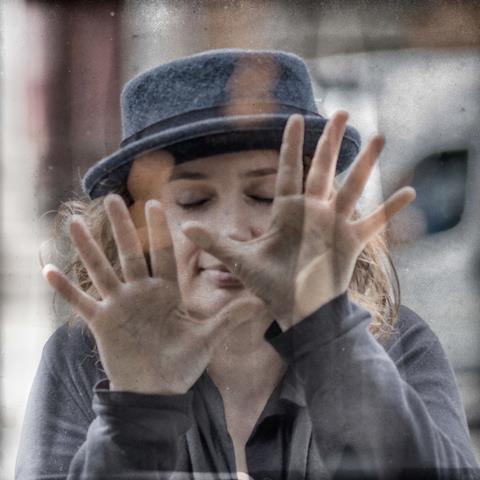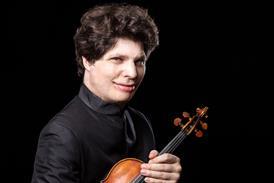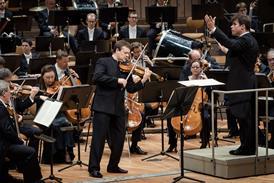US correspondent Thomas May speaks with Patricia Kopatchinskaja about playing Shostakovich’s Violin Concerto No. 1 on her current tour with the London Philharmonic Orchestra and Edward Gardner, which culminates in her long-overdue Carnegie Hall debut.

Discover more Featured Stories like this in The Strad Playing Hub
An interview with Patricia Kopatchinskaja elicits many of the same qualities that make the violinist’s performances so unforgettable: passionate engagement, omnivorous curiosity, illuminating spontaneity – all the while underscoring the vital importance of the music at hand.
A familiar presence for years in concert halls worldwide, Kopatchinskaja is making her long-overdue Carnegie Hall debut on 19 October in a concert with the London Philharmonic Orchestra and principal conductor Edward Gardner – the culmination of their fall US tour, which includes stops in California and the Midwest before their New York engagement.
The extraordinary violinist from Moldova is the featured soloist in six of the LPO’s concerts; Randall Goosby alternates in four additional engagements as the soloist for the Samuel Barber Violin Concerto. As part of its tour programme, the orchestra is also giving the US premiere of Raíces (Origins) by Tania León (currently composer-in-residence).
Kopatchinskaja – aka ‘PatKop’ – has chosen Shostakovich’s Violin Concerto No. 1 for her appearances with the orchestra. Especially known for her advocacy of contemporary composers as well as undervalued discoveries, she is also acclaimed for her ability to present canonical works from a vividly original perspective.
I experienced this aspect of PatKop’s artistry just last month when she partnered with Iván Fischer and the Budapest Festival Orchestra for a rhapsodic account of Bartók’s Violin Concerto No. 2 at the Lucerne Festival.
Particularly in the case of such familiar repertoire, the visual element of a PatKop performance – her feet often bare to keep her feeling connected with the Earth, her intensely expressive gestures body language – can evoke the sense of a ritual in progress, as if she’s communing with the spirit of a composer from the past.
Kopatchinskaja even designs staged concerts programmed around the issues that preoccupy her – from climate change (Les Adieux) to the role of music in a world besieged by war (Dona nobis pacem, her latest such project, which will be presented at Lucerne’s Forward contemporary music festival in November). Theatrical costuming enhances the impression that her concerts are not mere performances but events. For the Shostakovich concerto, she will play garbed in a hand-painted dress.
The day before beginning her tour, Kopatchinskaja talked about her work with the LPO and Gardner and expanded on what attracted her to the Shostakovich concerto.
You have a longstanding relationship with the London Philharmonic. What do you especially like about working with this orchestra?
These musicians are capable of doing anything you ask them to do in a musical sense. They are completely committed and focused, so no time is wasted. I admire them very much for their professionalism.
And I know some of them personally, because I often play an encore with the concertmaster or another player – a movement from Prokofiev’s Sonata for Two Violins, for example. These friendships are very important to me, because as a soloist you get only one or two rehearsals with the orchestra before the concert. For me it’s very personal. It’s about being together onstage with people that I like.
It’s an interesting coincidence that both you and Edward Gardner are making your Carnegie Hall debuts on this tour.
Ed and I first worked together when I played George Enescu’s Sonata No. 3 in an arrangement a friend of mine made for violin and orchestra. I had always regretted that Enescu never wrote for violin and orchestra. So I speculated whether one could consider making the Third Violin Sonata into an orchestral piece with a solo violin part.
I’m not so sure it was a good idea, but it was worth a try. We presented it at the Enescu Festival in Bucharest in 2021. I was stunned by Ed’s attention to every note, his ability to create together. We became friends, but as my calendar is completely full, it was only this year that we found time for this tour.
Why did you choose the Shostakovich concerto?
Actually, I had never been much interested in playing Shostakovich. I’m a very big fan of the music of his pupil, Galina Ustvolskaya. And find her music to be incredibly honest and personal and strong, without compromises. It’s all between herself and God, if he exists.
Ustvolskaya is the only one of his pupils that Shostakovich quoted in his music. According to some, he even proposed to her, but she refused. She actually disrespected him and found his music to be cheap.
So this was my way to into the musical world of Shostakovich. I became interested in going through her vision into his universe and was curious to play his music. It always functions, on any stage, in the hands of any musicians. This is a music that is ‘objective’. I think it’s really enough just to play what is written. There is nothing that that is necessary to add.
Yet when I play it onstage, I feel that there is another layer of expression that requires everything you have. As a soloist, you need to sacrifice your everything. And when you go to that level, something happens with this music. It takes out of the score, and it starts to say more: there is always this shadow.
I’ve been reading about Shostakovich’s life, about this constant threat and fear, knowing that every note he wrote after Lady Macbeth of Mtsensk was under the control of Stalin’s regime. He was literally in a prison, in an inner exile. This concerto was written in a time where he was rejected by anybody and lost his friends. Some of them just disappeared. There was no hope that anybody would play it.

And yet the concerto is now revered as a masterpiece and gets frequent performances.
Yet I think there is still a layer and a shadow world behind the concerto that is incredibly personal and subjective. This appears to be the first piece where Shostakovich used his musical signature [the notes corresponding to DSCH, his initials in German]. I also read the Requiem of Anna Akhmatova [an elegy about the Great Purge under Stalin], which to me is very much related to this music. The beginning reminds one of Tsar Boris, who saw himself as the executor of the will of the people.
That’s very interesting, because this is exactly what is happening today in Russia. It’s the same story again and again in Russia, like a circle that that doesn’t open. And that hurts me a lot, because I’m a Moldovan and my country is like Ukraine – in the pocket of the new tsar.
If Galina Ustvolskaya came back and were able to her you play this concerto, do you imagine that might have changed her mind about her disdain for Shostakovich?
All these figures from the time of Shostakovich are all on stage with me. Even Stalin is on stage. It is a constant dialogue with them. It’s the same when I play the Ligeti concerto, or Bartók, Kodaly, Machaut or Hartmann. All of these things are so connected.
It’s very much about staging the piece in different situations, because there are so many figures who influence this piece and who play an important role. So I always put them – maybe in different costumes – on different stage designs in my head, so I can refresh this piece and make it relevant to me. We have to enlarge our fantasy,
Does the context of playing the Shostakovich on a tour, in different locations night after night, and with musical friends you admire, affect your attitude towards the piece?
It changes constantly. I have no control to limit it to one form or one expression. It is like a child that grows, becoming older and sometimes also dying on stage. Then I have to reanimate it again. It has its own destiny.
Every single piece comes out of the hands of the composer – out of the composer’s inspiration and ability to put it down on paper. Our duty is to bring it out of the paper, to give life to it. And we also need to put all that we have into this text – all our soul and understanding, spirit and energy – and put it in the context of today, here and now. I think this is the only authentic and honest way of performing music.
Read: Joshua Bell and Steven Isserlis on their passion for Mendelssohn
Read: Rachel Barton Pine: ‘What we’re doing today is the history of tomorrow’
Listen: The Strad Podcast: Patricia Kopatchinskaja on Brahms, Bartók and Janáček
Discover more Featured Stories like this in The Strad Playing Hub.
The number one source for playing and teaching books, guides, CDs, calendars and back issues of the magazine.
In The Best of Technique you’ll discover the top playing tips of the world’s leading string players and teachers. It’s packed full of exercises for students, plus examples from the standard repertoire to show you how to integrate the technique into your playing.
The Strad’s Masterclass series brings together the finest string players with some of the greatest string works ever written. Always one of our most popular sections, Masterclass has been an invaluable aid to aspiring soloists, chamber musicians and string teachers since the 1990s.
The Canada Council of the Arts’ Musical Instrument Bank is 40 years old in 2025. This year’s calendar celebrates some its treasures, including four instruments by Antonio Stradivari and priceless works by Montagnana, Gagliano, Pressenda and David Tecchler.






































No comments yet